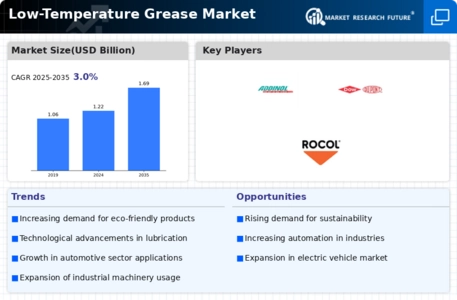Market Analysis
In-depth Analysis of Low-Temperature Grease Market Industry Landscape
The market dynamics of low-temperature grease are undergoing significant changes influenced by various factors that impact both the supply and demand sides of the industry. Low-temperature grease, a specialized lubricant formulated to operate effectively in cold environments, plays a crucial role in industries such as automotive, aerospace, and energy. The market dynamics are characterized by advancements in lubricant technology, seasonal variations, environmental considerations, and the diverse applications of low-temperature grease.
Advancements in lubricant technology are a key driver shaping the dynamic nature of the low-temperature grease market. Ongoing research and development efforts focus on formulating greases with superior low-temperature performance, ensuring efficient lubrication even in extreme cold conditions. These advancements lead to the production of greases with improved viscosity, stability, and anti-wear properties, impacting the overall performance and reliability of machinery and equipment operating in low-temperature environments. The continuous evolution of lubricant technology directly influences the market dynamics by raising the bar for performance expectations.
Seasonal variations play a significant role in influencing the demand for low-temperature grease. Industries operating in cold climates, such as those in northern regions, experience distinct seasonal changes, necessitating the use of lubricants capable of maintaining effectiveness at low temperatures. The demand for low-temperature grease tends to peak during winter months when temperatures drop significantly, impacting the overall market dynamics. Companies and end-users in these regions need to adapt to seasonal demands, ensuring that machinery remains well-lubricated in challenging weather conditions.
Environmental considerations are becoming increasingly important in shaping the market dynamics of low-temperature grease. As industries globally focus on sustainability and reducing their environmental footprint, the choice of lubricants comes under scrutiny. The development of environmentally friendly and biodegradable low-temperature greases aligns with these sustainability goals, influencing market dynamics by catering to the growing demand for eco-friendly lubrication solutions. The emphasis on reducing the environmental impact of industrial activities plays a crucial role in shaping the choices and preferences within the low-temperature grease market.
The diverse applications of low-temperature grease contribute significantly to the dynamic landscape of the market. From automotive components and machinery in cold storage facilities to aerospace applications and renewable energy installations, low-temperature grease finds use in a wide range of industries. The versatility of low-temperature grease ensures that its market dynamics are influenced by trends in multiple sectors, making it an essential lubricant for various applications where cold conditions prevail.
Competition within the market fosters innovation and efficiency in low-temperature grease production. Lubricant manufacturers are continually striving to differentiate themselves by offering high-quality products, exploring new formulations, and optimizing manufacturing processes. Collaborations between lubricant producers, research institutions, and end-users contribute to ongoing research and development, driving innovation and influencing the competitive landscape of the low-temperature grease market.
Socio-economic factors, including industrial activities, infrastructure development, and advancements in technology, contribute to the market dynamics of low-temperature grease. As industries expand, infrastructure projects increase, and technology evolves, the demand for reliable lubrication solutions capable of withstanding low temperatures rises. Economic trends and industrial growth directly impact the consumption of low-temperature grease, making it an essential component in the development and growth of various industries.







Leave a Comment